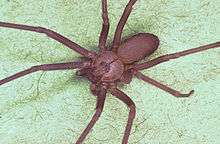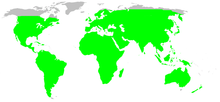Sicariidae
Sicariidae is a family of six-eyed venomous spiders known for their potentially necrotic bites. The family consists of three genera and about 160 species. Well known spiders in this family include the brown recluse spider and the six-eyed sand spider.
| Sicariidae | |
|---|---|
 | |
| Brown recluse spider (Loxosceles reclusa) | |
| Scientific classification | |
| Kingdom: | Animalia |
| Phylum: | Arthropoda |
| Subphylum: | Chelicerata |
| Class: | Arachnida |
| Order: | Araneae |
| Infraorder: | Araneomorphae |
| Superfamily: | Scytodoidea |
| Family: | Sicariidae Keyserling, 1880 |
| Genera | |
| |
| Diversity | |
| 3 genera, 189 species | |
 | |
| Synonyms[1] | |
| |
Description
Loxosceles, commonly known as "recluse spiders" or "violin spiders", is distributed nearly worldwide in warmer areas. Hexophthalma and Sicarius, commonly known as "sand spiders" or "assassin spiders", live in the deserts of southern Africa and South to Central America, respectively.[1] They are known for their self-burying behavior and the ability to go for long periods without food or water.[2]
All members have six eyes arranged in three groups of two (dyads). Violin spiders are usually brownish with a darker brown characteristic violin marking on the cephalothorax. They are also haplogyne, meaning the females possessing unsclerotised genitals.[3]
Hexophthalma and Sicarius resemble crab spiders and lack this marking. With the tarantulas, these are some of the longest living spiders, some living up to fifteen years old. Most Loxosceles can live for one and a half to two years.
Venom
All genera are able to produce sphingomyelinase D or a related tissue-destroying substance. It is unique to the family among spiders, and otherwise only found in a few pathogenic bacteria. Bites from most of the Neotropical species of Sicarius are not known to display dermonecrotic or systemic activity, except the highly venomous Sicarius ornatus which has active proteins of the sphingomyelinase D family found in the venom.[4][5]
The venom of many Sicariidae species is highly hemolytic and dermonecrotic,[2] capable of destroying red blood cells and causing lesions as large as 1 inch (25 mm) in diameter that take a long time to heal. Some require skin grafts and if the open wound gets infected, there can be even more serious consequences. Rarely, the venom is carried by the blood stream into internal organs causing systemic effects. Unlike spiders that use neurotoxins, many of the venoms used by these spiders do not have a known anti-venom.[2]
Taxonomy
The family was first described by Eugen von Keyserling in 1880,[3] and marked as a subfamily and synonym for "Loxoscelidae" in 1893.[6] The status of "Loxoscelidae" as a family or subfamily of "Sicariidae" has been argued both ways. The World Spider Catalog currently accepts Loxoscelinae as a subfamily of Sicariidae,[7] but this placement is still being debated.[8][9]
A phylogenetic study in 2017 showed that the African species of Sicarius were distinct, and placed them in the revived genus Hexophthalma. The relationship found between the genera is shown in the following cladogram:[5]
| Sicariidae |
| ||||||||||||
Genera
As of March 2019, the World Spider Catalog accepts the following genera:[1]
- Hexophthalma Karsch, 1879 – Namibia, South Africa
- Loxosceles Heineken & Lowe, 1832 – South America, North America, Asia, Africa, Central America, Caribbean, Finland, Australia
- Sicarius Walckenaer, 1847 – South America, Central America
See also
References
- "Family: Sicariidae Keyserling, 1880". World Spider Catalog. Natural History Museum Bern. Retrieved 2019-04-27.
- "Six Eyed Sand Spider". Animal Corner. Retrieved 2019-04-24.
- Keyserling, E. (1880). Die Spinnen Amerikas, I. Laterigradae.
- Binford, Greta J.; Wells, Michael A. (2003). "The phylogenetic distribution of sphingomyelinase D activity in venoms of Haplogyne spiders" (PDF). Comparative Biochemistry and Physiology B. 135: 25–33. doi:10.1016/s1096-4959(03)00045-9.
- Magalhães, I.L.F.; Brescovit, A.D. & Santos, A.J. (2017). "Phylogeny of Sicariidae spiders (Araneae: Haplogynae), with a monograph on Neotropical Sicarius". Zoological Journal of the Linnean Society. 179 (4): 767–864. doi:10.1111/zoj.12442.
- Simon, E. (1893). Histoire naturelle das araignées. p. 271.
- Platnick, N. I.; Coddington, J. A.; Forster, R. R.; Griswold, C. E. (1991). "Spinneret morphology and the phylogeny of haplogyne spiders (Araneae, Araneomorphae)". American Museum Novitates. 3016.
- Murphy, J. A.; Roberts, M. J. (2015). Spider families of the world and their spinnerets. British Arachnological Society, York.
- Wunderlich, J. (2004). "Fossil spiders (Araneae) of the superfamily Dysderoidea in Baltic and Dominican amber, with revised family diagnoses". Beiträge zur Araneologie. 3: 633–746.
External links
| Wikispecies has information related to Sicariidae |
| Wikimedia Commons has media related to Sicariidae. |
- "Loxosceles: Recluse spiders". Arachnology Home Pages. Archived from the original on 2003-10-11.
- "Family Sicariidae". Biodiversity Explorer. Archived from the original on 2005-12-07.
- Vetter, R. (2003). "Causes of Necrotic Wounds other than Brown Recluse Spider Bites". University of California, Riverside.
- Vetter, R. (2003). "Myth of the Brown Recluse Fact, Fear, and Loathing". University of California, Riverside.
- "Pictures of the Brown Recluse Spider". Archived from the original on 2006-06-15.